“Road to the Divan”
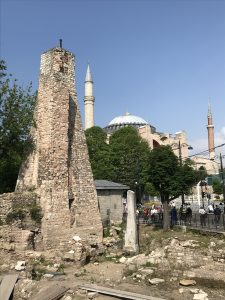
Virtually every visitor to İstanbul will at some point stroll along Divan Yolu, the road that runs from Ayasofya Meydanı (Square) to Çemberlitaş and its landmark battered Roman column. However, few of them will have any idea about the history that lies beneath their feet.
Once upon a time this was the street along which Ottoman dignitaries processed every week to attend meetings at the Divan (Council Chamber) in Topkapı Palace. But long before that it was the route of one of the main roads in the Roman and Byzantine city, forming part of the Via Egnatia that ran all the way to Durres (then Dyrrachium) on the Adriatic coast in Albania. After the 4th century when the Land Walls were built the length of the road inside them was renamed the Via Regia (Royal Road) although most people just called it the Mese (Main Road).
Not surprisingly, this is a road liberally peppered with minor historic monuments, now helplessly squeezed in amid rampant tourist desvelopment.
Along Divan Yolu
Insignificant as it now seems, one of the most important monuments on Divan Yolu is easily overlooked at the point immediately across the tramlines from Ayasofya Meydanı where the road starts. The small surviving fragment of the Miliarium Aureum (Golden Milestone, or Milyon for short) was once a monumental gateway that is thought to have served as a milestone from which all distances in the city were measured although some modern historians believe that they may have been measured instead from the Forum of Constantine, today’s Çemberlitaş Meydanı.
Today the Milyon stands beside the pretty late 18th-century Beşir Ağa fountain and a curious truncated tower that was a suterazi, part of the complex system through which water was distributed around the city. In 2024 archaeological excavations were being carried out in the adjacent plot of land.
Starting up Divan Yolu you will see on the left a tiny bust commemorating Halide Edip Adıvar (1884-1964), a Turkish nationalist and novelist who served in the Turkish army during the War of Independence.
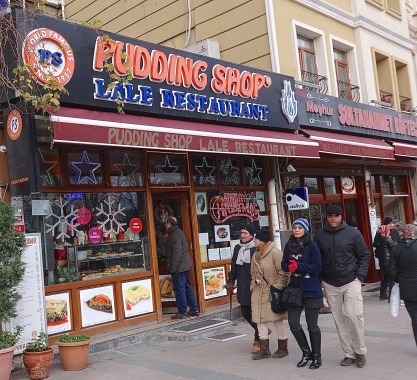 Shortly afterwards you will pass a group of long-lived sulu yemek and köfte restaurants. While today of no particular interest, one of them, the Lale Restaurant, holds a particular place in the hearts of ageing hippies worldwide as the original Pudding Shop where, in the 1970s, many gathered to exchange news and buy and sell their old vehicles at the start or end of journeys to Kathmandu. As such it played a walk-on part in the notoriously anti-Turkish movie Midnight Express.
Shortly afterwards you will pass a group of long-lived sulu yemek and köfte restaurants. While today of no particular interest, one of them, the Lale Restaurant, holds a particular place in the hearts of ageing hippies worldwide as the original Pudding Shop where, in the 1970s, many gathered to exchange news and buy and sell their old vehicles at the start or end of journeys to Kathmandu. As such it played a walk-on part in the notoriously anti-Turkish movie Midnight Express.
Past the Pudding Shop, the marble-faced Cevri Kalfa Primary School was built by Sultan Mahmud II in 1819 to show his gratitude after Cevri Kalfa, a slave girl in the Harem, saved his life during an uprising of the Janissaries when he was a prince. The building has had a chequered history. In 1858 it became a girls’ school, in 1930 a printing school, and in 1945 a primary school once again. Restored in 2009, it now houses an inviting branch of the Hafız Mustafa pastry shop.
Facing the Cevri Kalfa Primary School across the tramlines is the petite Firuz Ağa Cami that was built in 1491. With its triple-arched portico and single dome and minaret, it’s an exquisite example of the Bursa architectural style prevailing before grand courtyards and multiple minarets became fashionable.
Just past the mosque in the small park behind the Sultanahmet tram stop scattered ruins have been identified as the remains of the grand 5th-century palace of Antiochus who served as chamberlain to Emperor Arcadius and teacher to his son, Theodosius II. In the 7th century the site was reused as a church and became the burial place for St Euphemia, a Christian martyred for her faith in c. 300. The building was partually demolished in the 16th century. Supposedly restoration work has been completed on what remains of the church and its frescoes although in 2024 it was yet to open to the public. The park also contains a monument to Mehmed Akif Ersoy (1873-1936), author of the rousing İstiklal Marşı (Independence March), the Turkish national anthem.
Facing the tramstop the elegant 19th-century building that used to house a small health museum has been given a facelift but has not reopened since the Covid pandemic.
Continuing west along Divan Yolu you will come to a small cemetery with a large circular tomb jutting out onto the pavement. When he died in 1839, the reformist Sultan Mahmud II, who finally broke the power of the Janissaries in 1826, was buried here. Later it became the last resting place of Sultans Abdülaziz and Abdülhamid II too. The tomb was designed by Garabet Amir Balyan in 1840. The cemetery itself is also worth a quick look. Amongst those buried here are the Turkish nationalist Ziya Gökalp (1876-1924) and Şehzade Ertuğrul Osman (1912-2009), sometimes called the “Last of the Ottomans”.
Immediately across the road from the tomb a small red-brick building with dome and portico used to house the Köprülü Kütüphanesi (library), designed in 1661 as Turkey’s first privately-owned library and paid for by a Köprülü family father and son who both served time as grand viziers, Mehmed Paşa (1578-1661) and Fazıl Ahmed Paşa (1635-76). In 2024 it was undergoing restoration.
Crossing over the side street beside the cemetery you will pass a grand 19th-century building commissioned from the Swiss Fossati brothers by the grand vizier Saffed Paşa. The ground floor houses a small Press Museum (Basın Müzesi, closed Sundays) showcasing items associated with printing, journalism and photography (this part of town was once the throbbing heart of the printing industry).
Off Divan Yolu
A few historic attractions just off Divan Yolu are worth brief diversions.
If you turn left along İmren Öktem Caddesi just past the ruins of the Palace of Antiochus you will pass, on the right, the entrance to the Binbirdirek Sarnıç (Cistern of 1001 Pillars). Less romantic than the Basilica Cistern in Yerebatan Caddesi, this cistern is also much less visited which means you won’t have to queue to get in at busy times. The second largest of İstanbul’s many underground water storage units, the cistern was probably built in the fifth or sixth century although some date it back to the fourth. In truth it has only 224 columns; the name may be a corruption of “bindirme dilek“, a reference to the way the columns were built up by layering the stones, but it’s just as likely that “binbir” was used to suggest a large number as in the case of Binbirkilise (1001 Churches), near Karaman.
If you turn left down the street beside the Pierre Loti Hotel, then right at the end of it you will see the entrance to the 4th-century Şerifiye Sarnıç or Theodosius Cistern (open daily, admission TL550, Turks TL88). This now stages sound-and-light shows amid a myriad columns. The colourful carved creatures outside the entrance represent the Şahmaran, a Mesopotamian fertility deity.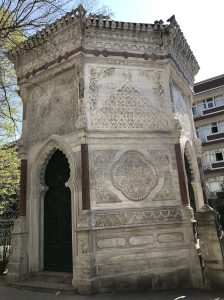
At the junction with Klodfarer Caddesi turn left and walk to the end where it bears left towards the Hippodrome. Here you will find the rather ordinary Fuad Paşa Cami with, beside it, the elaborately carved tomb of the founder, the reformist grand vizier, Keçicizade Fuad Paşa (1814-69). Its design is said to have been inspired in part by the Alhambra in Spain.
Fans of crime writer Barbara Nadel might like to know that her famously chain-smoking Inspector İkmen lived in a house in Ticarethane Sokak, off Divan Yolu.
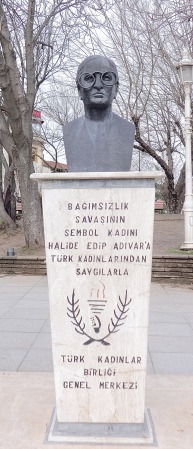 Eating
Eating
There are endless choices of places to eat on and around Divan Yolu although most charge over the odds for meals that are less interesting than what you could find for less money on İstiklal Caddesi in Beyoğlu. Narrow Ticarethane Sokak in particular is full of places to eat although most turn out to be owned by the same people.
Amedros With a few tables outside in an alley and many more inside, the Amedros is a great place for a meal which, while hardly cheap, won’t completely break your budget (provided you ignore the allure of the desserts). A lengthy menu features all the Turkish staples but also offers some more imaginative mains that might or might not have appeared on Ottoman menus. Hoca Rüstem Paşa Sokak No. 7, Tel: 0212-522 8356
Çiğdem Pastanesi A long-time personal favourite, this little cafe has been serving up sweet and savoury pastries with coffee since long before Starbucks put down roots on Divan Yolu. Who could possibly resist the strawberry tarts in the window? Divan Yolu No. 62A, Tel: 0212-526 8859
Karadeniz Aile Pide ve Kebap Salonu If all you want is a cheap fill-up, then the Karadeniz has been dispensing its own piping hot take on the Turkish pizza since the days of the hippies. Hacı Tahşınbey Sokak No. 1, Tel: 0212-528 6290
Khorasani Restaurant Spreading over three floors and out into the street, the Khorasani majors on the spicy cuisine of the Hatay including künefe (a hot dessert of melted cheese and cracked wheat). Kayıkçı (Tel: 0212-519 12 17) next door is the fishy part of the same stable. Ticarethane Sokak No. 39-41, Tel: 0212- 519 59 59
Mozaik Restaurant Spilling out from a wooden house into the adjoining alley and pavement, Mozaik has been offering reliably good and filling meals to visitors for decades now. Prices have risen steeply but portions remain satisfyingly sizeable. İncili Çavuş Sokak No. 1, Tel: 0212-512 4177
Tarihi Sultanahmet Köftecisi Something of an institution these days with branches all over the country, this evergreen restaurant concentrates on what it does best, namely köfte (meatballs) with piyaz (white beans), ayran (yoghurt drink), salata (salad) and ekmek (bread). During Ramazan queues for iftar start early and wind down the street. Divan Yolu No. 4, Tel: 0212-511 3960
Sleeping
Ambassador Hotel. Tel: 0212-512 0002
Arcadia Hotel. Tel: 0212-516 9696
Nomade Hotel. Tel: 0212-511 1296
Pierre Loti Hotel. Tel: 0212-518 5700
Tan Hotel. Tel: 0212-520 9130
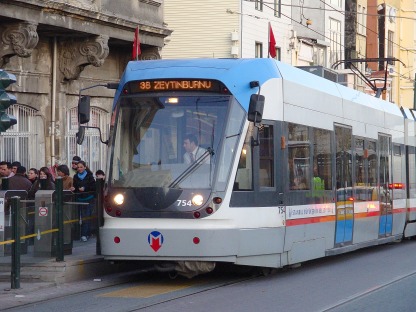 On holidays the trams fly tiny Turkish flagsTransport info
On holidays the trams fly tiny Turkish flagsTransport info
Although most people will probably walk to Divan Yolu from their hotels in Sultanahmet it is also readily accessible from the eastern end via the Sultanahmet tramstop or from the western end via the Çemberlitaş tramstop.
Nearby areas


